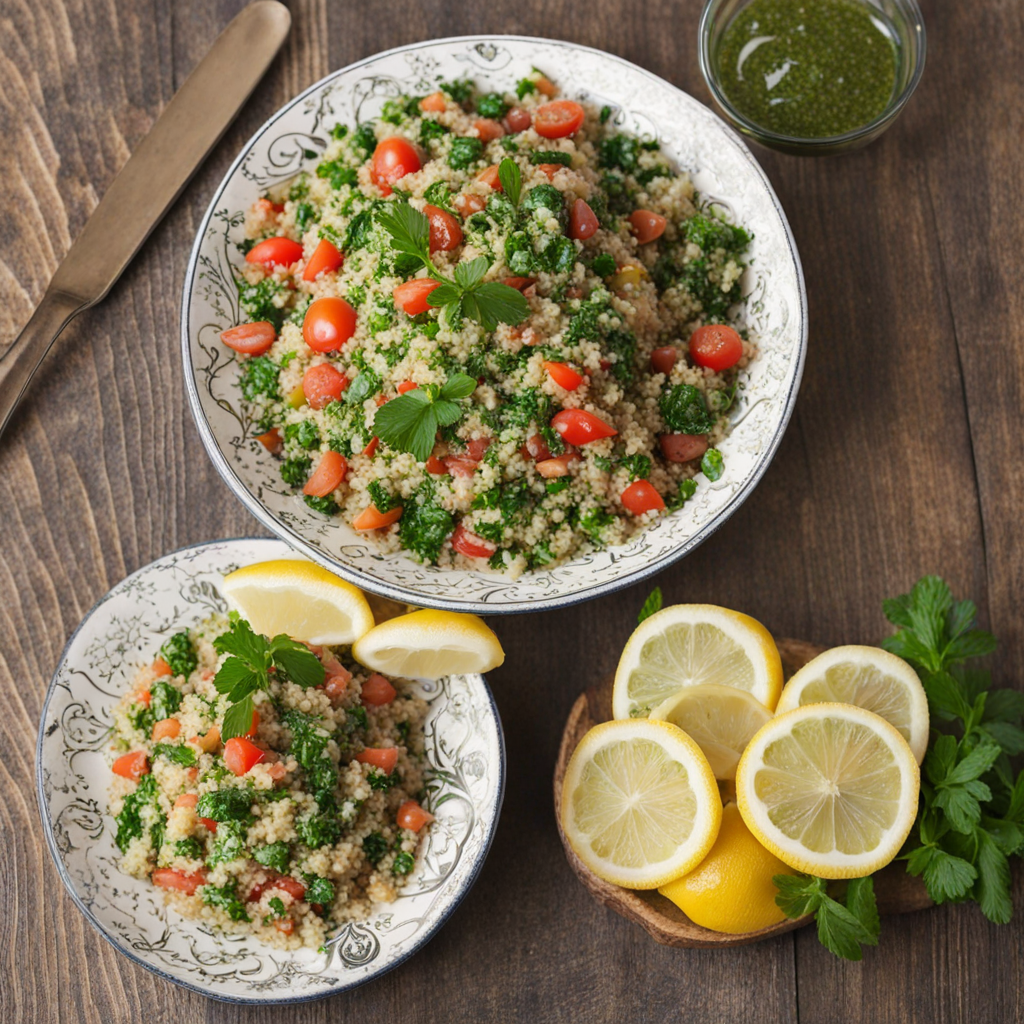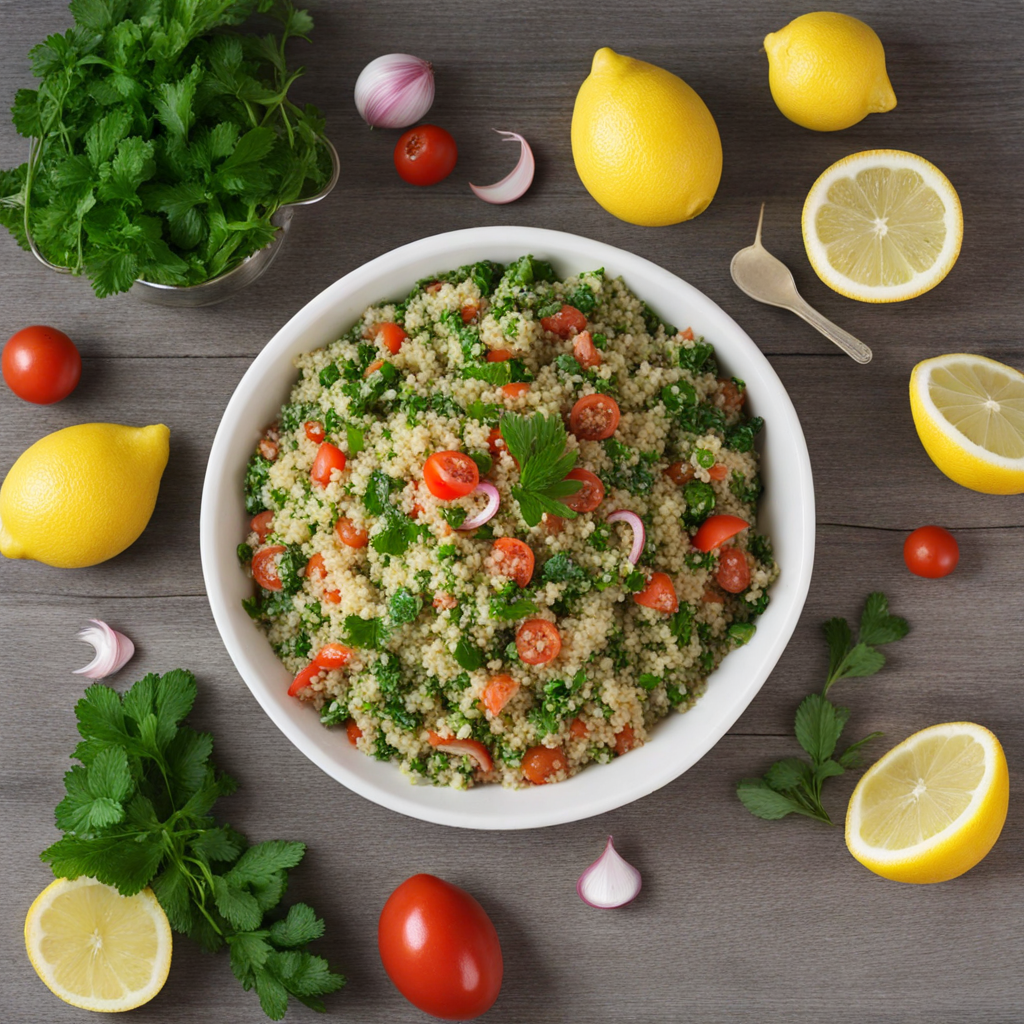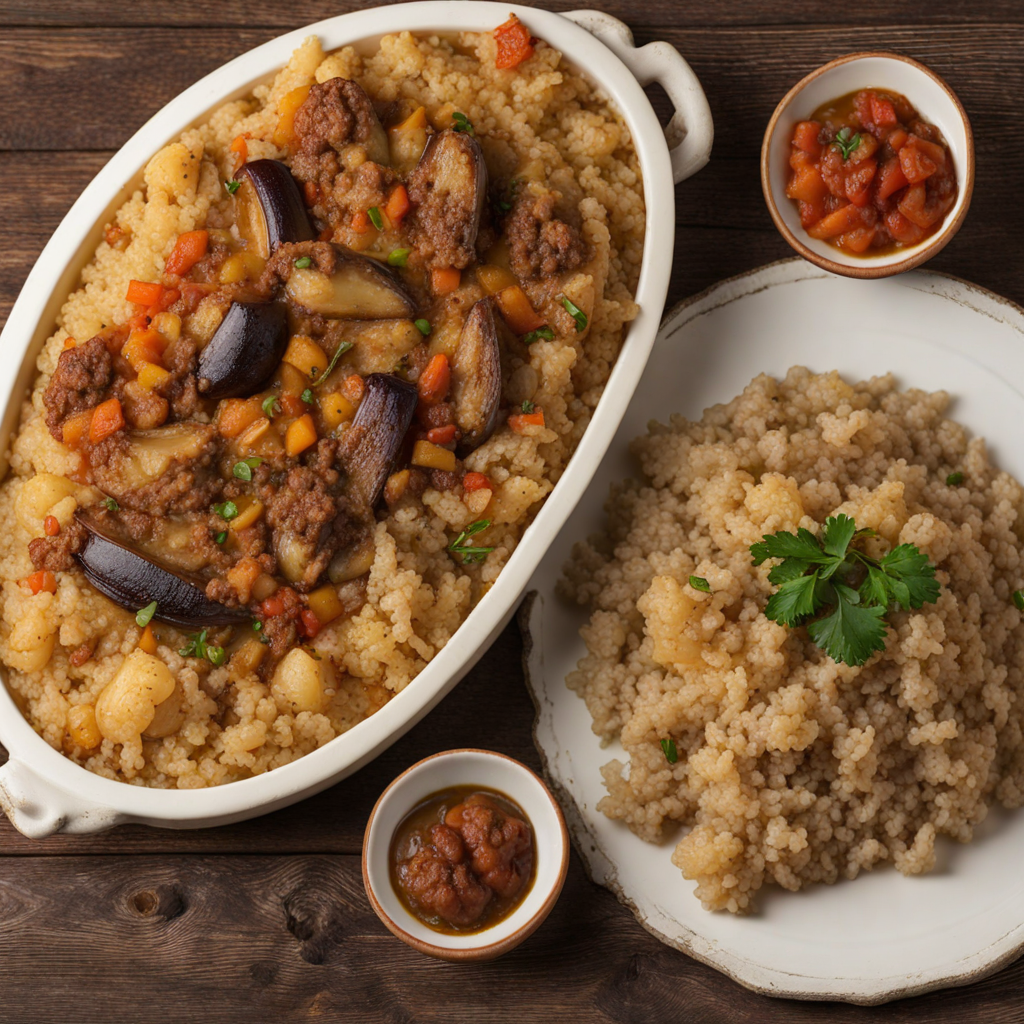Tabbouleh
Tabbouleh, a vibrant and refreshing salad, hails from the Levant region, with its roots deeply embedded in the culinary traditions of Jordan, Lebanon, and Syria. This dish has a rich history that dates back to ancient times, often associated with the agricultural practices of the fertile crescent. Originally, it was a peasant dish, made with whatever greens were available, but it has evolved into a beloved staple in Middle Eastern cuisine, celebrated for its fresh flavors and health benefits. The flavor profile of tabbouleh is a delightful interplay of fresh herbs, citrus, and grains, making it a perfect accompaniment to many dishes. The predominant taste comes from finely chopped parsley, which provides a bright, slightly peppery note. The addition of mint leaves enhances this freshness, adding a cooling effect that balances the acidity of the lemon juice. The salad's complexity is further enriched by the subtle sweetness of ripe tomatoes and the crunchiness of finely diced cucumbers. The bulgur wheat, soaked and fluffed, adds a nutty undertone that complements the other ingredients, while the olive oil brings a lush richness to the dish. Preparation of tabbouleh is straightforward yet requires attention to detail to achieve the perfect balance of flavors. First, bulgur wheat is rinsed and soaked in water until it is tender but not mushy. Once prepared, it is drained and squeezed to remove excess moisture. Meanwhile, fresh parsley is meticulously washed and finely chopped, often requiring a sharp knife to ensure the leaves
How It Became This Dish
Origin of Tabbouleh Tabbouleh, a vibrant and refreshing salad, is believed to have originated in the mountainous regions of the Levant, particularly in modern-day Lebanon and Syria, but it has significant cultural roots in Jordan as well. The dish is primarily made from finely chopped parsley, tomatoes, mint, onion, and soaked bulgur, all seasoned with olive oil, lemon juice, salt, and pepper. The use of bulgur, which is cracked wheat, is essential, as it adds a hearty texture to the dish while complementing the fresh herbs. The origins of tabbouleh can be traced back to ancient civilizations in the region, where herbs were commonly used not only for flavor but also for their health benefits. Parsley, one of the main ingredients, was known in antiquity for its medicinal properties, and its use in tabbouleh signifies the blend of cuisine with health consciousness that has characterized Middle Eastern food culture for centuries. Cultural Significance in Jordan In Jordan, tabbouleh is more than just a salad; it is a symbol of hospitality and celebration. The dish is often served during communal meals, family gatherings, and festive occasions, embodying the values of sharing and togetherness that are central to Jordanian culture. Its bright colors and fresh flavors exemplify the bountiful produce of the region, particularly the parsley and tomatoes grown in Jordan’s fertile lands. Tabbouleh also holds a special place in the context of Jordan's diverse culinary heritage. The country has a rich tapestry of influences due to its geographical location at the crossroads of various civilizations. As a result, tabbouleh has been adapted and integrated into the local cuisine, reflecting both traditional practices and contemporary tastes. The dish serves as a bridge between different cultures, showcasing the shared culinary threads among neighboring countries while celebrating the unique Jordanian identity. Evolution Over Time The evolution of tabbouleh has been marked by variations in ingredients and preparation methods, influenced by regional preferences and the availability of local produce. Traditionally, tabbouleh was made predominantly with parsley and bulgur, but over time, the recipe has evolved to include a higher ratio of parsley to bulgur, especially in Lebanon. This shift emphasizes the freshness of the herbs and allows for a lighter, more herbaceous flavor profile, which has been embraced in Jordan as well. In contemporary Jordan, tabbouleh is often customized to suit individual tastes, with variations that may include the addition of other ingredients such as cucumbers or bell peppers. Some modern interpretations even incorporate quinoa as a substitute for bulgur, catering to health-conscious diners and those with gluten sensitivities. Such adaptations highlight the dish's versatility and its ability to resonate with changing dietary trends while still maintaining its essence. Regional Variations and Comparisons While tabbouleh is commonly associated with Lebanon, it is important to note the regional variations that exist across the Levant. In Jordan, the dish is typically characterized by a more generous use of parsley, which is often chopped finely to create a more cohesive texture. Additionally, the balance of ingredients may differ slightly, with Jordanians favoring a bolder flavor profile achieved through the use of fresh lemon juice and high-quality olive oil. In contrast, Syrian tabbouleh may incorporate more bulgur, resulting in a heartier salad. The use of spices and additional ingredients can also vary, with some regions opting for a more complex flavor palette that includes spices like sumac or even pomegranate seeds for a touch of sweetness. These differences illustrate how tabbouleh has adapted to local tastes while remaining a beloved staple across the Levant. Tabbouleh in Modern Cuisine In recent years, tabbouleh has gained international recognition and popularity, becoming a symbol of Middle Eastern cuisine on the global stage. Its healthy ingredients align well with contemporary dietary trends that emphasize fresh, whole foods, making it a favored choice in health-conscious restaurants and eateries worldwide. The rise of vegetarian and vegan diets has also contributed to its popularity, as tabbouleh is naturally plant-based and full of nutrients. In Jordan, chefs and home cooks alike have embraced the global interest in tabbouleh, experimenting with fusion recipes that blend traditional ingredients with global flavors. This has led to innovative dishes that maintain the spirit of tabbouleh while appealing to diverse palates. For instance, some chefs may incorporate elements of Mediterranean cuisine, using ingredients like feta cheese or olives alongside the classic components of tabbouleh. Tabbouleh and Sustainability The growing interest in local and sustainable food practices has also had a positive impact on tabbouleh's preparation in Jordan. Many Jordanian farmers are increasingly focused on organic farming and sustainable practices, which enhance the quality and flavor of the produce used in tabbouleh. By sourcing ingredients locally, cooks not only support their community but also ensure that their tabbouleh is made from the freshest possible ingredients. Moreover, the emphasis on seasonal produce reflects the traditional practices of the region, where the availability of ingredients dictated the recipes and cooking methods. This connection to the land and local agriculture is a vital aspect of Jordanian culture and is especially evident in dishes like tabbouleh, which celebrates the bounty of the earth. Conclusion Tabbouleh is a dish steeped in history and cultural significance, embodying the essence of Jordanian hospitality and the rich culinary heritage of the Levant. Its evolution over time reflects the adaptability of regional cuisine, as it continues to resonate with contemporary tastes and dietary preferences. As tabbouleh becomes increasingly popular worldwide, it serves as a reminder of the interconnectedness of cultures and the shared love for fresh, wholesome food. Whether enjoyed as a side dish, a main course, or a part of a larger spread, tabbouleh remains a timeless staple that captivates the senses and nurtures the spirit of community.
You may like
Discover local flavors from Jordan







